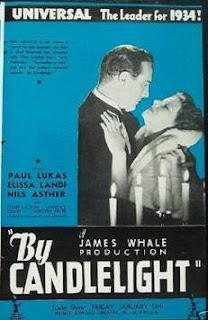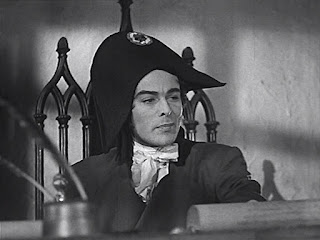Nils Asther
6: Free agent and to England 1933-1941
6: Free agent and to England 1933-1941
Nils Asther had been under contract with MGM since 1928. Almost from the start, he was outspoken in the press about his disappointment with the variety of the roles he was offered.
"I want to do character parts," he told Motion Picture Magazine's Cecil Belfrage in 1929, "to put on a beard, if necessary, and line my face. As a star I would never be allowed that. No I must be romantic. I must receive fan letters."
In the end, he left MGM in 1933, but his plan did not exactly work out. The parts still did not come. Even away from the studio system, he was generally cast as the other man in romantic love triangles. He landed increasingly less prestigious pictures and by 1934 had appeared in his first B movie, The Love Captive.
The Right to Romance, 1933, RKO, dir Alfred Santell
This was Asther's first freelance film after leaving MGM. Hhe took the opportunity to play the good-guy role for a change, Dr Helmuth 'Heppie' Heppling, who secretly pines after plastic surgeon Dr Peggy Simmons (Ann Harding). But she decides to instead rediscover her femininity instead outside the hospital by marrying playboy Bobby (Robert Young).
If I Were Free (Behold We Live) 1933, RKO, dir Elliot Nugent
Asther is back in his usual casting here as Tono Casanove, the no-good husband of Irene Dunne, who yearns to be free of him and marry Clive Brook instead.

Watch the film on - youtube
Reviews
By Candlelight (Court-Circuit) 1933, Universal, dir James Whale
In this deft comedy, with dialogue by PG Wodehouse, Asther is Prince von Rommel, a cad who takes his pleasure among all-too-willing married aristocratic ladies. His butler, Josef (Paul Lukas) tries to copy these techniques, but meets would-be Countess Marie (Elissa Landi) and comes a cropper.



more about this film
Reviews
Madame Spy, 1934, Universal, dir Karl Freund
- review from 1934 by the New York Times
- modern review from the NY Times
The Crime Doctor, 1934, RKO, dir John S Robertson
A criminologist (Otto Kruger) discovers that his wife (Karen Morley) is having an affair with an author (Nils Asther). He revenge by designing the perfect murder so that Asther is implicated and must stand trial.
Reviews
- 1934 review by the New York Times
- modern review from the NY Times
The Crime Doctor, 1934, RKO, dir John S Robertson
A criminologist (Otto Kruger) discovers that his wife (Karen Morley) is having an affair with an author (Nils Asther). He revenge by designing the perfect murder so that Asther is implicated and must stand trial.
Reviews
- 1934 review by the New York Times
The Love Captive, 1934, Universal, dir Max Marcin
Love Time (Serenade) 1934, Fox Film Corporation, dir James Tinling
Asther plays the composer Franz Schubert in this extremely romanticised biopic, with Pat Patterson as his high-born love interest. Hans Wollstein notes, "both leads were badly miscast."





more about this film
Reviews
- 1934 review by the New York Times
LEAVING HOLLYWOOD
'How would YOU like to be hypnotized into loving, lying and sacrificing for a man whom at heart you hated?'
In this melodrama, Nils Asther, minus his moustache, plays Dr Alexis Collender, a gifted psychiatrist with somewhat unorthodox methods.
Reviews
Love Time (Serenade) 1934, Fox Film Corporation, dir James Tinling
Asther plays the composer Franz Schubert in this extremely romanticised biopic, with Pat Patterson as his high-born love interest. Hans Wollstein notes, "both leads were badly miscast."





more about this film
Reviews
- 1934 review by the New York Times
LEAVING HOLLYWOOD
Asther's last two pictures had not been a success.
Critic Hans Wollstein describes The Love Captive as nothing less than a B-movie, and as for his next film, "Love Time did nothing for Asther's now floundering career and played mostly the lower half of a double bill. Like a host of other waning Hollywood "names", Asther sought greener pastures in England."
Asther was to make 5 pictures for British companies.
Critic Hans Wollstein describes The Love Captive as nothing less than a B-movie, and as for his next film, "Love Time did nothing for Asther's now floundering career and played mostly the lower half of a double bill. Like a host of other waning Hollywood "names", Asther sought greener pastures in England."
Asther was to make 5 pictures for British companies.
Nils Asther aboard ship, 1935
Abdul the Damned (Abdul Hamid, Le Sultan Rouge, Il Sultano Rosso) 1935, Alliance-Capital Productions (UK), dir Karl Grune
In this historical biopic, set just before WWI, Asther was the corrupt Kadar-Pasha, Chief of Police to Sultan Abdul Hamid of Turkey (Fritz Kortner). The Young Turks are threatening to revolt, but amidst the political tension, the Sultan becomes infatuated with Adrienne Ames, a Viennese actress.



Film set at Elstree, England
Reviews
Film Weekly, September 20th, 1935- New York Times review from 1935
The acting honours are naturally coniscated by the star - all of them - although Esmé Percy, as the Grand Eunuch, succeeds in turning in a notable supporting performance, and Nils Asher is theatrically effective as the Chief of Police.
- Tall Armenian Tale blog
- Malcolm Lowry
The Marriage of Corbal (The Prisoner of Corbal) 1936, Capitol Film Corporation (UK), dir Karl Grune
This French revolution melodrama is based on a romance novel by Rafael Sabatini. Asther is Citizen-Deputy of the Revolution, Varennes, who saves a young French noblewoman from the guillotine and disguises her as his nephew. Unfortunately for Varennes, the lady prefers the company of the Marquis of Corbal. In retaliation, the Deputy enacts a ridiculous law compelling everyone to marry immediately. Location filming was in the Portuguese countryside.
Scenes from the film



more about this film
Reviews
- Hal Erickson, Rovi
- attack on the film by the novelist Graham Greene in the Spectator, 1936
Guilty Melody (Die schuldige Stimme) 1936, Franco London Films (UK), dir Richard Pottier
Gitta Alper is cast as Mme. Marguerite Savini, a celebrated Hungarian opera star. Her romance with British intelligence officer Richard Carter (John Loder) leads to dire consequences, forcing her into an espionage plot against the British government. The villain of the piece is Mme. Savini's husband Galloni (Nils Asther), who blackmails her into making a phonograph record containing a secret code message. The melodrama is never permitted to impede upon the musical highlights, which include an operatic medley performed early in the proceedings by star Gitta Alper. Based on a novel by Hans Rehfisch, Guilty Melody was simultaneously filmed in a French-language version, Disque 413.
~ Hal Erickson, Rovi
 |
| Gitta Alpar |
Make Up 1937, Standard International (UK), dir Alfred Zeisler
Asther plays Bux, a most unusual clown, as he is not only a top-billing circus artist but also a sophisticated, multi-lingual, gifted ex-surgeon. While at a society book launch, Bux meets Joy (June Clyde), and the two become an item. Meanwhile, back at the circus, his adopted daughter Tania (Jill Craigie) is beginning to have feelings for him (this part of the story is strangely similar to Asther's earlier silent movie Laugh, Clown, Laugh).

screencaps coming soon
Tea Leaves in the Wind (Hate in Paradise) 1938, Chesterfield Films (UK), dir Ward Wing
In this drama, set in Ceylon (now Sri Lanka), a pretty niece (Eve Shelley) visits her uncle's plantation. There she finds the drunken sot (Gibson Gowland) on the brink of financial ruin by the crooks that are quietly victimizing him. Meanwhile the young woman falls in love (with Nils Asther). ~ Sandra Brennan, Rovi
 |
| Gibson Gowland |
The plantation melodrama, featuring Eve Shelley and Hollywood expatriate Gibson Gowland, was trite and unconvincing, receiving a low-keyed release in the US retitled as Hate in Paradise...
Abdul the Damned... was the only film made during his five years in London to get a review in the New York Times.
With the outbreak of WWII, Asther returned to Hollywood.
Hans Wollstein, Strangers in Hollywood, Scarecrow Press, 1994
More about the films of Nils Asther
6: this page








































